Tragedy of the Commons in a Mediterranean MPA: The Case of Gyaros Island Marine Reserve
Abstract
1. Introduction
2. Materials and Methods
2.1. Fishing Surveys
2.2. Statistical Analyses of Catch Data
2.3. Surveys of Fishers Perceptions on the Gyaros MPA
3. Results
3.1. Fishing Surveys
3.2. Surveys of Fishers’ Opinion
3.3. Establishing the MPA
4. Discussion
4.1. Inability to Properly Implement Fisheries Management in the MPA
4.2. Tragedy of the Commons and Small-Scale Fishers
4.3. The Future (Lessons Learned/Recommendations)
- (a)
- The legislative status of the MPA must be finalized through the issuance of a definitive Presidential Decree and a science-based, regularly updated Management Plan,
- (b)
- The effective surveillance and guarding of the MPA and fishing activities within it must be secured by providing the necessary administrative framework as well as adequate means to the Hellenic Coast Guard and to the newly established MPA Management Agency (NECCA/Management Unit of the Central Aegean Protected Areas), to be able to effectively operate in situ, utilizing all available technologies, such as the existing remote monitoring and surveillance system,
- (c)
- Ensure the continuation of the necessary scientific monitoring of the status of the marine environment within the MPA and the surrounding area to assess the effectiveness of the conservation measures and be able to adaptively manage the Gyaros MPA and
- (d)
- Ensure the involvement of the local communities, through substantial participatory processes, in the MPA’s management and to promote the notion and value of the “commons” among key users, including fishers.
Author Contributions
Funding
Institutional Review Board Statement
Informed Consent Statement
Data Availability Statement
Acknowledgments
Conflicts of Interest
References
- Day, J.; Dudley, N.; Hockings, M.; Holmes, G.; Laffoley, D.; Stolton, S.; Wells, S. Guidelines for Applying the IUCN Protected Area Management Categories to Marine Protected Areas; IUCN: Gland, Switzerland, 2012; p. 36. Available online: https://portals.iucn.org/library/sites/library/files/documents/PAG-019-2nd%20ed.-En.pdf (accessed on 27 December 2023).
- Partnership for Interdisciplinary Studies of Coastal Oceans and University of Nice Sophia Antipolis. 2016. The Science of Ma-rine Protected Areas (3rd edition, Mediterranean). 22p. Available online: www.piscoweb.org (accessed on 27 December 2023).
- Agardy, T.; Bridgewater, P.; Crosby, M.P.; Day, J.; Dayton, P.K.; Kenchington, R.; Peau, L. Dangerous targets? Unresolved issues and ideological clashes around marine protected areas. Aquat. Conserv. Mar. Freshw. Ecosyst. 2003, 13, 353–367. [Google Scholar] [CrossRef]
- Goñi, R.; Badalamenti, F.; Tupper, M.H. Fisheries-Effects of marine protected areas on local fisheries: Evidence from empirical studies. In Marine Protected Areas: A Multidisciplinary Approach; Claudet, J., Ed.; Cambridge University Press: Cambridge, UK, 2011; pp. 72–98. [Google Scholar]
- Czybulka, D.; Bosecke, T. Marine Protected Areas in the EEZ in light of international and European Community law—Legal basis and aspects of implementation. In Progress in Marine Conservation in Europe; Von Nordheim, H., Boedeker, D., Krause, J.C., Eds.; Springer: Berlin/Heidelberg, Germany, 2006. [Google Scholar] [CrossRef]
- Marine Conservation Institute. Share of Marine Protected Areas in the Exclusive Economic Zone (EEZ) Area of Selected Countries as of April 2023. Statista. Available online: https://www.statista.com/statistics/1334647/share-of-marine-protected-areas-in-eez-of-selected-countries/ (accessed on 14 February 2024).
- EC. European Commission. Directorate-General for Environment. EU Biodiversity Strategy for 2030: Bringing Nature Back into our Lives; Publications Office of the European Union: Luxembourg, 2021; Available online: https://data.europa.eu/doi/10.2779/677548 (accessed on 16 February 2024).
- Guidetti, P.; Baiata, P.; Ballesteros, E.; Di Franco, A.; Hereu, B.; Macpherson, E.; Micheli, F.; Pais, A.; Panzalis, P.; Rosenberg, A.A.; et al. Large-Scale Assessment of Mediterranean Marine Protected Areas Effects on Fish Assemblages. PLoS ONE 2014, 9, e91841. [Google Scholar] [CrossRef] [PubMed]
- Damalas, D.; Stamouli, C.; Fotiadis, N.; Kikeri, M.; Kousteni, V.; Mantopoulou-Palouka, D. The Gyaros island marine reserve: A biodiversity hotspot in the eastern Mediterranean Sea. PLoS ONE 2022, 17, e0262943. [Google Scholar] [CrossRef] [PubMed]
- Karamanlidis, A.A.; Adamantopoulou, S.; Paravas, V.; Psaradellis, M.; Dendrinos, P. Demographic structure and social behavior of the unique Mediterranean monk seal colony of the island of Gyaros. In Proceedings of the 20th Biennial Conference on the Biology of Marine Mammals, Dunedin, New Zealand, 9–13 December 2013. [Google Scholar]
- Dendrinos, P.; Karamanlidis, A.A.; Adamantopoulou, S.; Koemtzopoulos, K.; Komninou, A.; Tounta, E. MOm/Hellenic Society for the Study and Protection of the Monk seal. In LIFE-IP 4 NATURA: Integrated Actions for the Conservation and Management of Natura 2000 Sites, Species, Habitats and Ecosystems in Greece. Deliverable Action Α.1: Action Plan for the Mediterranean Monk Seal (Monachus monachus); Hellenic Ministry of Environment and Energy: Athens, Greece, 2020; p. 105. [Google Scholar]
- LIFE12 NAT/GR/000688) “CYCLADES LIFE: Integrated Monk Seal Conservation in Northern Cyclades. Available online: http://cycladeslife.gr/ (accessed on 17 January 2024).
- WWF. Final Report: Securing Gyaros MPA Sustainability through a Pioneer Remote Surveillance System. 2021. Available online: https://www.fondationsegre.org/securing-gyaros-mpa-sustainability-thoughpioneer-remote-surveillance-system/ (accessed on 14 February 2024).
- “Gyaros MPA Fisheries Knowledge Survey: Assessing a Pristine Mediterranean Biodiversity Hotspot” (Grant Agreement 17114). Available online: https://cloudfs.hcmr.gr/index.php/s/jcOviUGK1BoFIxM (accessed on 14 February 2024).
- “Empowering the Legacy of MAVA Mediterranean Partnership: Scaling up Co-Managed and Financially Sustainable No-Take Zones/Marine Protected Areas” (Grant Agreement 20139_20130). Available online: https://cloudfs.hcmr.gr/index.php/s/q1qhoB1PXDNmHpz (accessed on 14 February 2024).
- Kavvadas, S.; Damalas, D.; Tserpes, G.; Georgakarakos, E.; Papaconstantinou, C.; Maravelias, C. IMAS-Fish—Integrated Management System to support the sustainability of Greek fisheries resources. A multidisciplinary web-based database management system: Implementation, capabilities, utilization and future prospects for fisheries stakeholders. Mediterr. Mar. Sci. 2012, 14, 109–118. [Google Scholar] [CrossRef]
- Zar, J.H. Biostatistical Analysis; Pearson Prentice-Hall: Upper Saddle River, NJ, USA, 2010; p. 662. [Google Scholar]
- R Core Team. R: A Language and Environment for Statistical Computing; R Foundation for Statistical Computing: Vienna, Austria, 2022; Available online: https://www.R-project.org (accessed on 16 February 2024).
- Shannon, C.E. A mathematical theory of communication. Bell Syst Tech. J. 1948, 27, 379–423. [Google Scholar] [CrossRef]
- Clarke, K.; Gorley, R. Primer v5: User Manual/Tutorial; Primer-E: Plymouth, UK, 2001; p. 91. [Google Scholar]
- Macedo, H.S.; Medeiros, R.P.; McConney, P. Are multiple-use marine protected areas meeting fishers’ proposals? Strengths and constraints in fisheries’ management in Brazil. Mar. Policy 2019, 99, 351–358. [Google Scholar] [CrossRef]
- Cánovas-Molina, A.; García-Frapolli, E. Untangling worldwide conflicts in marine protected areas: Five lessons from the five continents. Mar. Policy 2020, 121, 104185. [Google Scholar] [CrossRef]
- Gómez, S.; Carreño, A.; Lloret, J. Cultural heritage and environmental ethical values in governance models: Conflicts between recreational fisheries and other maritime activities in Mediterranean marine protected areas. Mar. Policy 2021, 129, 104529. [Google Scholar] [CrossRef]
- Ingimundarson, V. Fighting the Cod Wars in the Cold War: Iceland’s challenge to the Western Alliance in the 1970s. RUSI J. 2003, 148, 88–94. [Google Scholar] [CrossRef]
- Blake, A.; Campbell, G.A. Conflict over flying fish: The dispute between Trinidad & Tobago and Barbados. Mar. Policy 2007, 31, 327–335. [Google Scholar]
- Shih, Y.C.; Chang, Y.C.; Gullett, W.; Chiau, W.Y. Challenges and opportunities for fishery rights negotiations in disputed waters—A Taiwanese perspective regarding a fishing boat case incident. Mar. Policy 2020, 121, 103755. [Google Scholar] [CrossRef]
- Roszko, E. Chapter 8: Spectacular Fishing: Embodying Sovereignty in the post-Brexit Channel Islands and the South China Sea. In Variations on Sovereignty: Contestations and Transformations from around the World; Taylor & Francis Group: Routledge, UK, 2023; p. 22. Available online: https://www.taylorfrancis.com/chapters/oa-edit/10.4324/9781003287506-12/spectacular-fishingembodying-sovereignty-post-brexit-channel-islands-south-china-sea-edyta-roszko (accessed on 14 February 2024).
- Hellenic Parliament. The Constitution of Greece. Revised by Resolution of November 25, 2019 of the IXth Revisionary Parliament; Hellenic Parliament: Athina, Greece, 2022; 156p, ISBN 978-960-560-221-5. [Google Scholar]
- Hardin, G. The tragedy of the commons: The population problem has no technical solution; it requires a fundamental extension in morality. Science 1968, 162, 1243–1248. [Google Scholar] [CrossRef] [PubMed]
- Purvis, V. Self-interest and the Common Good. BMJ 1970, 1, 692. [Google Scholar] [CrossRef]
- Ostrom, E. Governing the Commons: The Evolution of Institutions for Collective Action; Cambridge University Press: Cambridge, UK, 1990; p. 280. [Google Scholar]
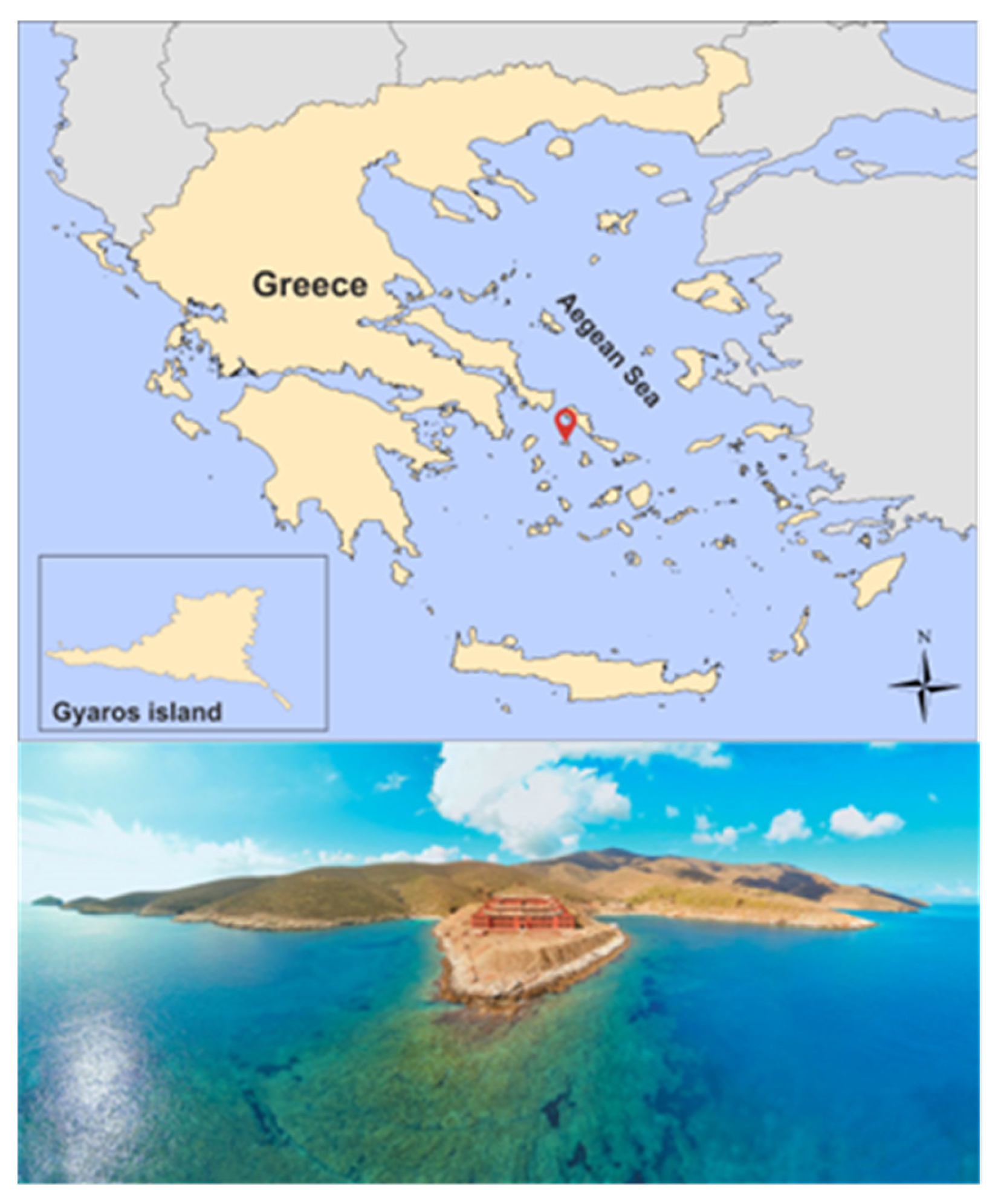
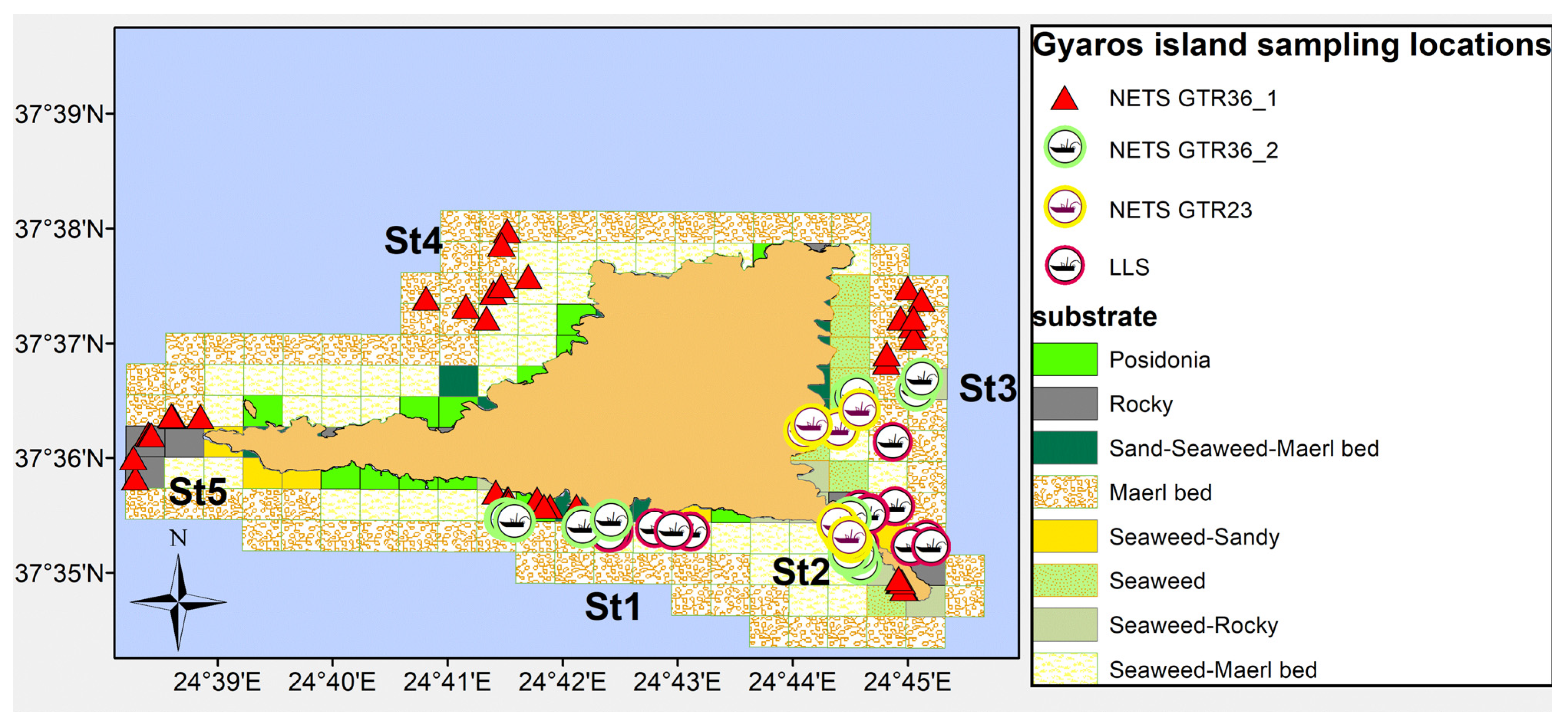
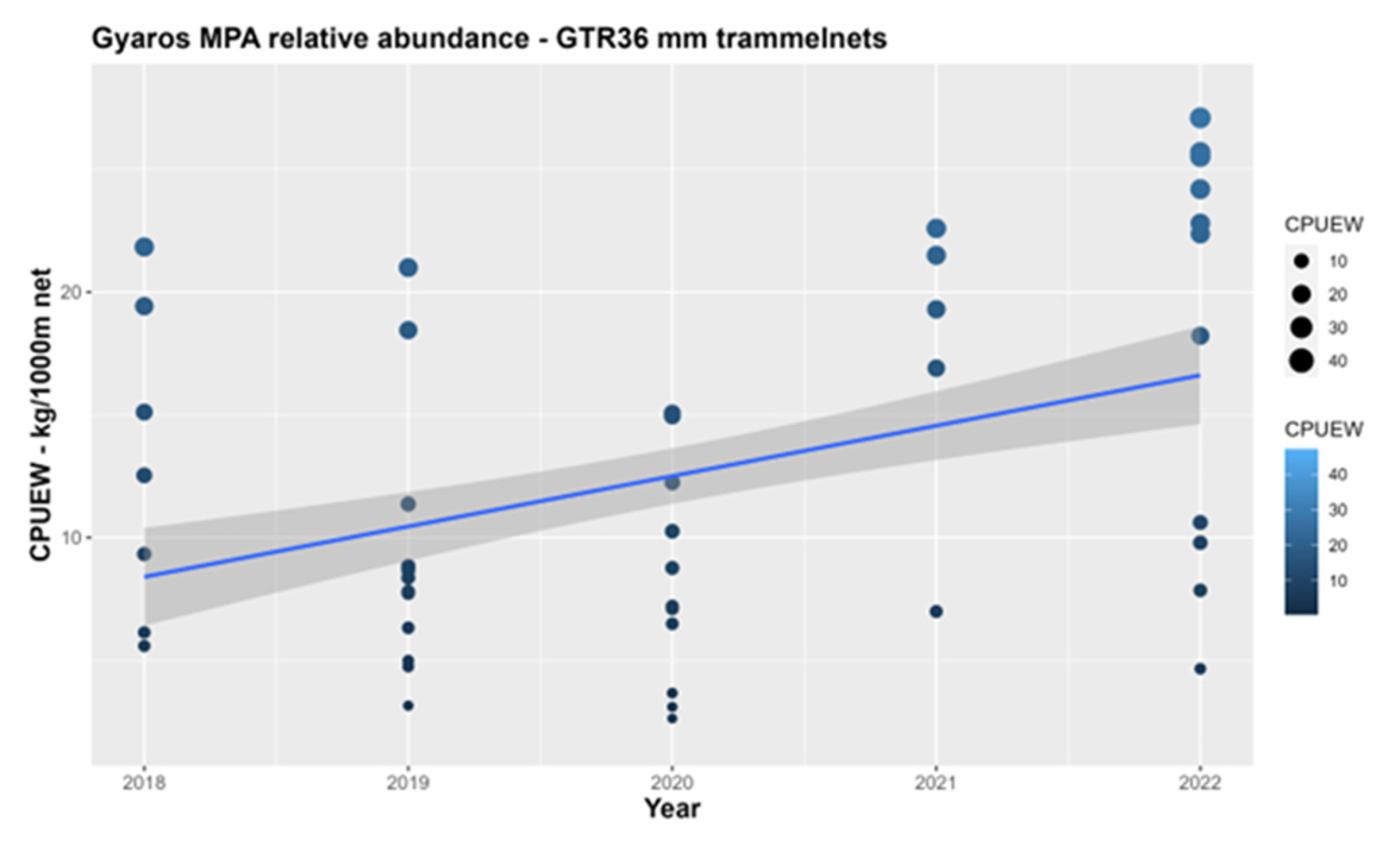
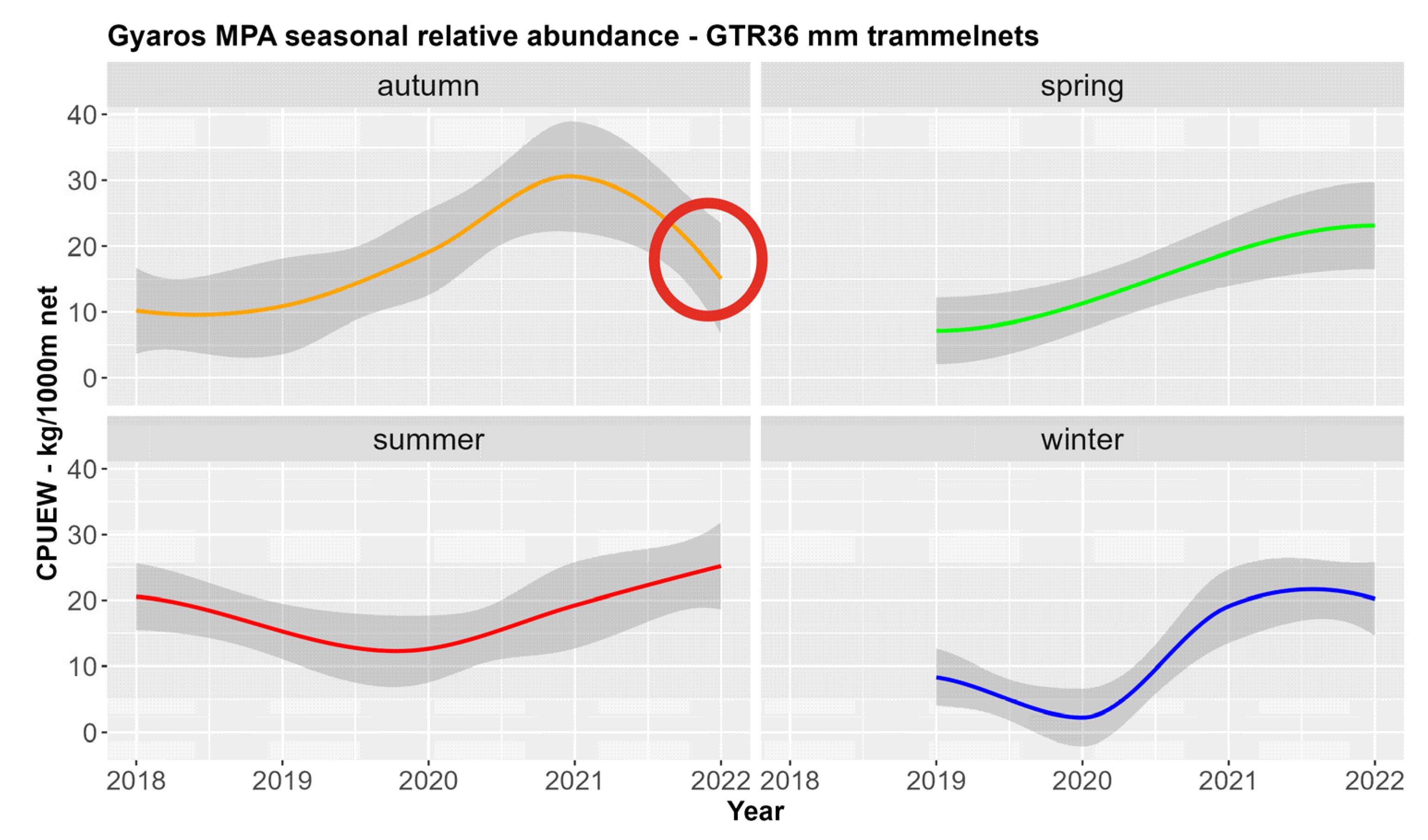
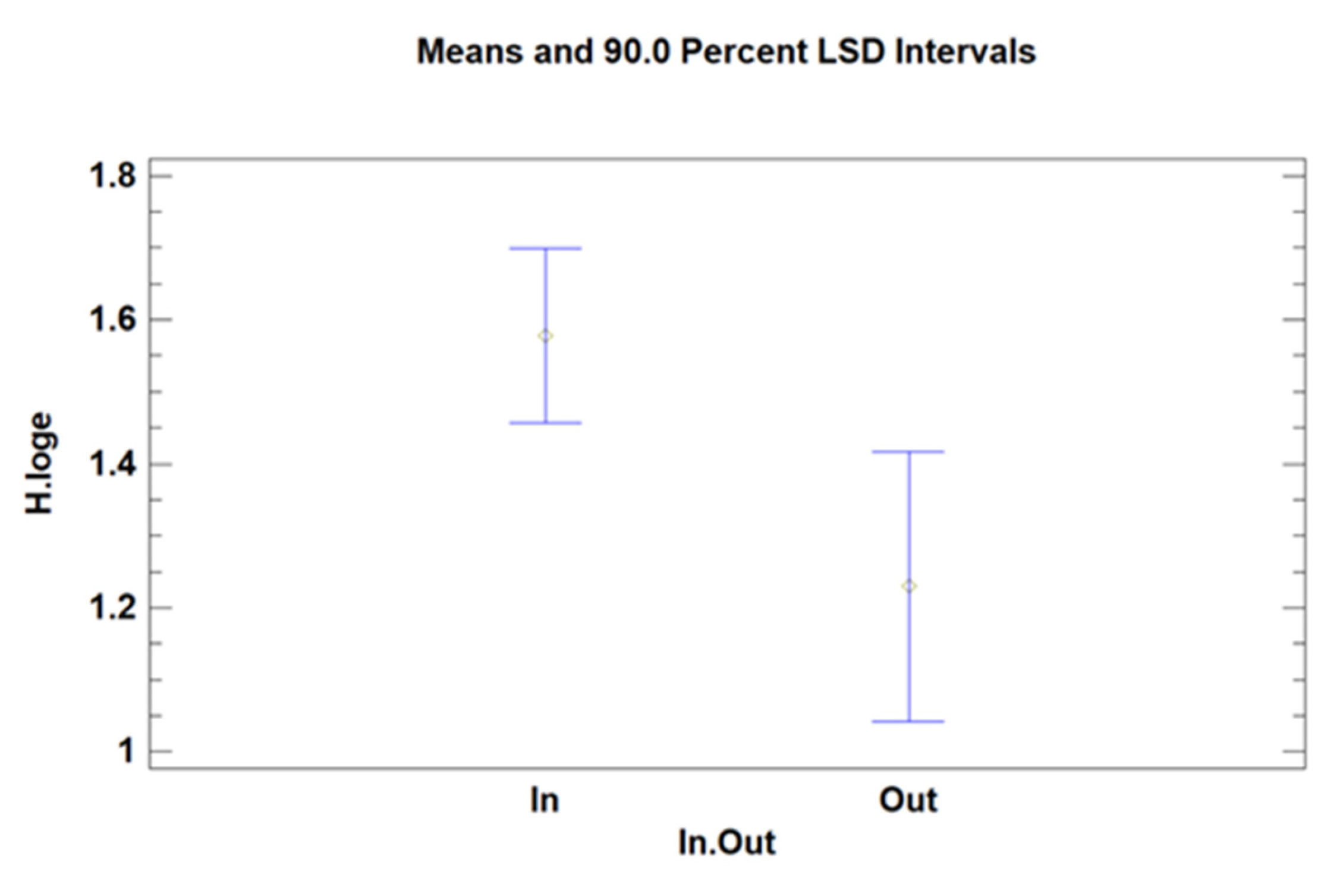
| (a) | ||||||
|---|---|---|---|---|---|---|
| GYAROS MPA QUESTIONAIRES | ||||||
| Island | SYROS | ANDROS | KYTHNOS | |||
| No. of active fishers responding(% of overall active fishers) | 19 (70.4%) | 8 (22.9%) | 10 (55.6%) | |||
| Age group | <20 | 20–29 | 30–39 | 40–49 | 50–59 | 60+ |
| 0 | 0 | 8 | 7 | 17 | 5 | |
| Length of boat | 0–6 m | 6–12 m | 12–14 m | 14+ m | ||
| 2 | 29 | 6 | 0 | |||
| Q 1. Do you know what is a Marine Protected Area (MPA)? | Yes, but I do not know in detail | Yes, an area for the conservation of marine life with rules and restrictions for all human activities | Yes, an area for the conservation of marine life with rules and restrictions only for fisheries | Yes, an area for the conservation of marine life where all forms of fishing are forbidden | No, I do not know | Do not have an opinion/Do not wish to answer |
| Answered | 3 | 14 | 10 | 8 | ||
| Q 2. Your opinion on the establishment of MPAs is: | Positive | Negative | Neutral | Do not have an opinion/Do not wish to answer | ||
| Answers | 32 | 4 | 1 | 0 | ||
| Q 3. Do you have direct knowledge of personal experience of the function of an MPA from Greece or from abroad? | Yes | No | I have received information from others | Do not have an opinion/Do not wish to answer | ||
| Answered | 18 | 8 | 9 | 2 | ||
| Q 4. Do you believe that fisheries should be allowed within an MPA? | Yes, all forms of fisheries should be allowed but should be specifically regulated | Only professional small scale fisheries should be allowed but in specific zones and with specific regulations (e.g., with specified gear) | Only recreational fisheries should be allowed but in specific zones and with specific regulations | No form of fisheries should be allowed | ||
| Answered | 5 | 23 | 0 | 8 | ||
| Q 5. Do you believe that within MPAs there should be a No Take Zone throughout the year? | Yes | No | Do not have an opinion/Do not wish to answer | |||
| Answered | 19 | 15 | 3 | |||
| (b) | ||||||
| Q 6. Do you know the existence of the Gyaros MPA? | Yes | No | Do not have an opinion/Do not wish to answer | |||
| Answered | 37 | 0 | 0 | |||
| Q 7. Do you know the fisheries regulations that exist within the Gyaros MPA? | Yes, I know well the measures | Yes, but I am not certain of their details | No, I do not know them | Do not have an opinion/Do not wish to answer | ||
| Answered | 28 | 8 | 1 | 0 | ||
| Q 8. Do you consider that the fisheries measures within the Gyaros MPA had an impact? | Yes, positive for biodiversity | Yes, positive on fish-stocks | Yes, positive on my income | Yes, negative on my income | No, had no impact of any kind | Do not have an opinion/Do not wish to answer |
| Answered | 6 | 22 | 1 | 1 | 2 | 5 |
| Q 9. Do you know how the Gyaros MPA fisheries measures were developed? | By the relevant Ministries | By scientists | By environmental NGOs | Jointly by all stakeholders including fishers | Do not have an opinion/Do not wish to answer | |
| Answered | 0 | 0 | 0 | 15 | 22 | |
| Q 10. You believe that the fisheries measures within the Gyaros MPA should… | Be changed and become stricter | Be changed and become less strict | Should remain the same | Should be abolished | Do not have an opinion/Do not wish to answer | |
| Answered | 9 | 4 | 16 | 3 | 3 | |
| Q 11. Do you believe that more MPAs should be established in the Cyclades region? | Yes, many more | Yes, a few selected ones | No, we do not need more | No, we should also abolish the existing ones | Do not have an opinion/Do not wish to answer | |
| Answered | 4 | 22 | 5 | 4 | 2 | |
| Period | Area | GTR23 | GTR36 | LLS |
|---|---|---|---|---|
| 2018–2020 | Inside MPA | 11.0 | ||
| Outside MPA | 7.9 * | |||
| 2021–2022 | Inside MPA | 17.0 | 20.6 | 52.5 |
| Outside MPA | 16.0 | 8.3 * | 24.4 * |
| Year | CPUEW (kg/1000 m of Net) | Nb of Species |
|---|---|---|
| 2018 | 10.2 | 16 |
| 2019 | 10.9 | 12 |
| 2020 | 19.1 | 11 |
| 2021 | 30.6 | 14 |
| 2022 | 15.1 | 7 |
| 2018–2022 | GTR 36 mm Nets | |
|---|---|---|
| Inside MPA | Outside MPA | |
| Winter | 1.62 | 1.08 |
| Spring | 1.88 | 1.31 |
| Summer | 1.75 | 1.48 |
| Autumn | 1.35 | 1.51 |
| Fishing Gear | Survey | CPUEW | Nb of Species |
|---|---|---|---|
| GTR36 | May 2022 | 23.1 | 22 |
| September 2022 | 15.1 * | 15 | |
| GTR23 | May 2022 | 19.9 | 21 |
| September 2022 | 15.3 * | 21 | |
| LLS | May 2022 | 52.6 | 19 |
| September 2022 | 13.9 * | 5 |
| Agreement between Stakeholders “Gyaros Co-Management Committee” March 2018 | Rules as Set in Ministerial Decision of 4 July 2019 | What Actually Happened between 4 July 2019–10 May 2022 | Rules as Set in Ministerial Decision of 10 May 2022 | Rules as Set in Ministerial Decision of 15 September 2022 |
|---|---|---|---|---|
| 1. Fishing permits | Coast guard declines permit issuing—This was not foreseen in the agreement signed between the 15 relevant stakeholders of the Gyaros Co-management Committee (Coast guard and Ministry included) → MPA functions as a de facto NTZ * | No permit | Gyaros declared a No-Take Zone; Pending a Special Environmental Study which will lead to a Presidential Decree | |
| To be issued by MPA Management authority | To be issued by Coast guard | |||
| valid per individual vessel | yes | |||
| 48 h duration | yes | |||
| Priority access to local small-scale fishers (SSF) | no | no ** | no | |
| 2. Zoning system | yes | yes | yes | |
| 3. Temporal access to SSF (June–October) | yes | no | yes | |
| 4. Static Gillnets | no | |||
| Max net length = 4000 m | yes | - | yes | |
| mesh size ≥ 22 mm | yes | - | yes | |
| 5. Static Trammelnets | no | |||
| Max net length = 4000 m | yes | - | yes | |
| mesh size ≥ 23 mm | yes | - | yes | |
| 6. Static longlines | no | |||
| max Nb of hooks = 1000 | yes | - | yes | |
| hook size ≥ 12 | yes | - | yes | |
| 7. Logbook obligation | No logbook obligation | |||
| all catches reported to management authority | yes | no | ||
| 8. All other NATURA2000 obligations/restrictions apply | yes | yes | yes |
Disclaimer/Publisher’s Note: The statements, opinions and data contained in all publications are solely those of the individual author(s) and contributor(s) and not of MDPI and/or the editor(s). MDPI and/or the editor(s) disclaim responsibility for any injury to people or property resulting from any ideas, methods, instructions or products referred to in the content. |
© 2024 by the authors. Licensee MDPI, Basel, Switzerland. This article is an open access article distributed under the terms and conditions of the Creative Commons Attribution (CC BY) license (https://creativecommons.org/licenses/by/4.0/).
Share and Cite
Damalas, D.; Kotomatas, S.; Alberini, A.; Stamouli, C.; Fotiadis, N. Tragedy of the Commons in a Mediterranean MPA: The Case of Gyaros Island Marine Reserve. Sustainability 2024, 16, 1918. https://doi.org/10.3390/su16051918
Damalas D, Kotomatas S, Alberini A, Stamouli C, Fotiadis N. Tragedy of the Commons in a Mediterranean MPA: The Case of Gyaros Island Marine Reserve. Sustainability. 2024; 16(5):1918. https://doi.org/10.3390/su16051918
Chicago/Turabian StyleDamalas, Dimitrios, Spyros Kotomatas, Amalia Alberini, Caterina Stamouli, and Nikolaos Fotiadis. 2024. "Tragedy of the Commons in a Mediterranean MPA: The Case of Gyaros Island Marine Reserve" Sustainability 16, no. 5: 1918. https://doi.org/10.3390/su16051918
APA StyleDamalas, D., Kotomatas, S., Alberini, A., Stamouli, C., & Fotiadis, N. (2024). Tragedy of the Commons in a Mediterranean MPA: The Case of Gyaros Island Marine Reserve. Sustainability, 16(5), 1918. https://doi.org/10.3390/su16051918







